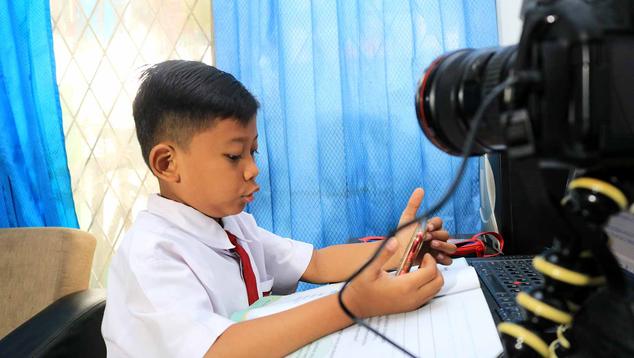Story Highlights
- Education satisfaction fell from 85% to 63% in Southeast Asia last year
- Declines in Indonesia and the Philippines among the largest in the world
- Satisfaction fell most among residents struggling on current income
WASHINGTON, D.C. -- As their schools shut down in-person teaching during the first year of the COVID-19 pandemic, children around the world faced massive disruptions to their education. The World Bank estimates that at the peak of school closures in April 2020, 94% of students worldwide were not learning in person. As difficult as the changes were for children in high-income countries, they were much worse for many of those in developing regions, where internet access is often unreliable and many children already faced barriers to a high-quality education.
In several of these regions, satisfaction with local schools fell significantly between 2019 and 2020 among adults with children younger than 15 in their household. But the largest drop occurred in Southeast Asia, the region where education satisfaction had previously been the highest in the world. The regional figure fell from 85% satisfied in 2019 to 63% in 2020.
| 2019 | 2020 | |
|---|---|---|
| % Satisfied | % Satisfied | |
| Southeast Asia | 85 | 63 |
| Latin America | 63 | 49 |
| Middle East/North Africa | 48 | 40 |
| East Asia | 78 | 70 |
| Eastern Europe | 64 | 62 |
| Russia/Caucasus/Central Asia | 66 | 64 |
| Sub-Saharan Africa | 57 | 56 |
| South Asia | 78 | 77 |
| Western Europe | 70 | 70 |
| Australia/New Zealand | 77 | 79 |
| Northern America | 69 | 72 |
| Gallup World Poll | ||
This decline is largely attributable to results from Southeast Asia's two largest countries: Indonesia and the Philippines. Both are among a handful of countries worldwide in which satisfaction with local schools dropped at least 25 percentage points. Satisfaction also fell significantly in several other countries in the region -- including Thailand, Malaysia and Vietnam -- though not to the same extent as in Indonesia and the Philippines.
| 2019 | 2020 | |
|---|---|---|
| % Satisfied | % Satisfied | |
| Philippines | 89 | 56 |
| Indonesia | 82 | 55 |
| Thailand | 90 | 75 |
| Malaysia | 88 | 76 |
| Vietnam | 87 | 78 |
| Myanmar | 80 | 73 |
| Cambodia | 91 | 85 |
| Laos | 83 | 78 |
| Gallup World Poll | ||
Unlike in most Southeast Asian countries, most schools in both Indonesia and the Philippines remained closed throughout 2020 (World Poll interviewing in the region took place predominantly in the fall and winter of 2020). In Indonesia, government ministries provided distance education tools such as online learning and educational television, though these measures are less accessible to students with limited internet access and lower socioeconomic backgrounds. Similarly, many Filipinos lack the devices and infrastructure for remote learning, and education-related activities were severely restricted between March and October 2020.
Education Satisfaction Fell Most Among Indonesians, Filipinos Struggling to Get By
As among many other populations, the school closures during the pandemic may have widened existing inequalities in education access and quality among Indonesians and Filipinos. While satisfaction with local schools dropped sharply across socioeconomic groups in both countries, it fell further among those who said they were finding it "difficult" or "very difficult" to get by on their current income than among those who said they were "living comfortably." The result is that the gaps in education satisfaction between these groups were wider in 2020 than they were in 2019.
| 2019 | 2020 | |
|---|---|---|
| % Satisfied | % Satisfied | |
| Indonesians who are living comfortably on their current income | 89 | 70 |
| Indonesians who are getting by on their current income | 82 | 55 |
| Indonesians who are finding it difficult or very difficult on their current income | 74 | 48 |
| Gallup World Poll | ||
| 2019 | 2020 | |
|---|---|---|
| % Satisfied | % Satisfied | |
| Filipinos who are living comfortably on their current income | 93 | 65 |
| Filipinos who are getting by on their current income | 89 | 60 |
| Filipinos who are finding it difficult or very difficult on their current income | 88 | 52 |
| Gallup World Poll | ||
In both countries, residents who said they were struggling to get by were also less likely to have internet access than those who were living comfortably on their income. In Indonesia, 72% of those who said they were living comfortably on their current income had internet access, versus 53% of those who were finding it very difficult. In the Philippines, the corresponding figures are 82% vs. 67%.
Implications
In Indonesia and the Philippines, the sharp drop in satisfaction with local schools highlights the difficult choices facing governments tasked with protecting students' health in the short term, while mitigating the long-term negative effects of learning loss. International organizations have called for urgent action to address the longer-term effects of the pandemic on children's education in low-income countries. In addition to the direct effect of school closures, economic disruption during the pandemic has strained public spending on education in many countries and increased the risk of dropouts as students are needed to help support family incomes.
The findings also call attention to specific challenges in Southeast Asia that may have made the changes particularly disruptive to student learning. For example, though internet access is widespread in the region, most residents do not own laptop or tablet computers and go online primarily using mobile phones, which may be less conducive to online learning. A recent World Bank report estimates that in Indonesia, the pandemic could result in a loss of between 0.9 and 1.2 years of learning-adjusted schooling. It also notes that the extent of learning loss is affected more by the effectiveness of distance learning than by the length of time schools were closed, highlighting the need to better equip students and make education systems more resilient even in the most vulnerable communities.
To stay up to date with the latest Gallup News insights and updates, follow us on Twitter.
For complete methodology and specific survey dates, please review Gallup's Country Data Set details.
Learn more about how the Gallup World Poll works.




